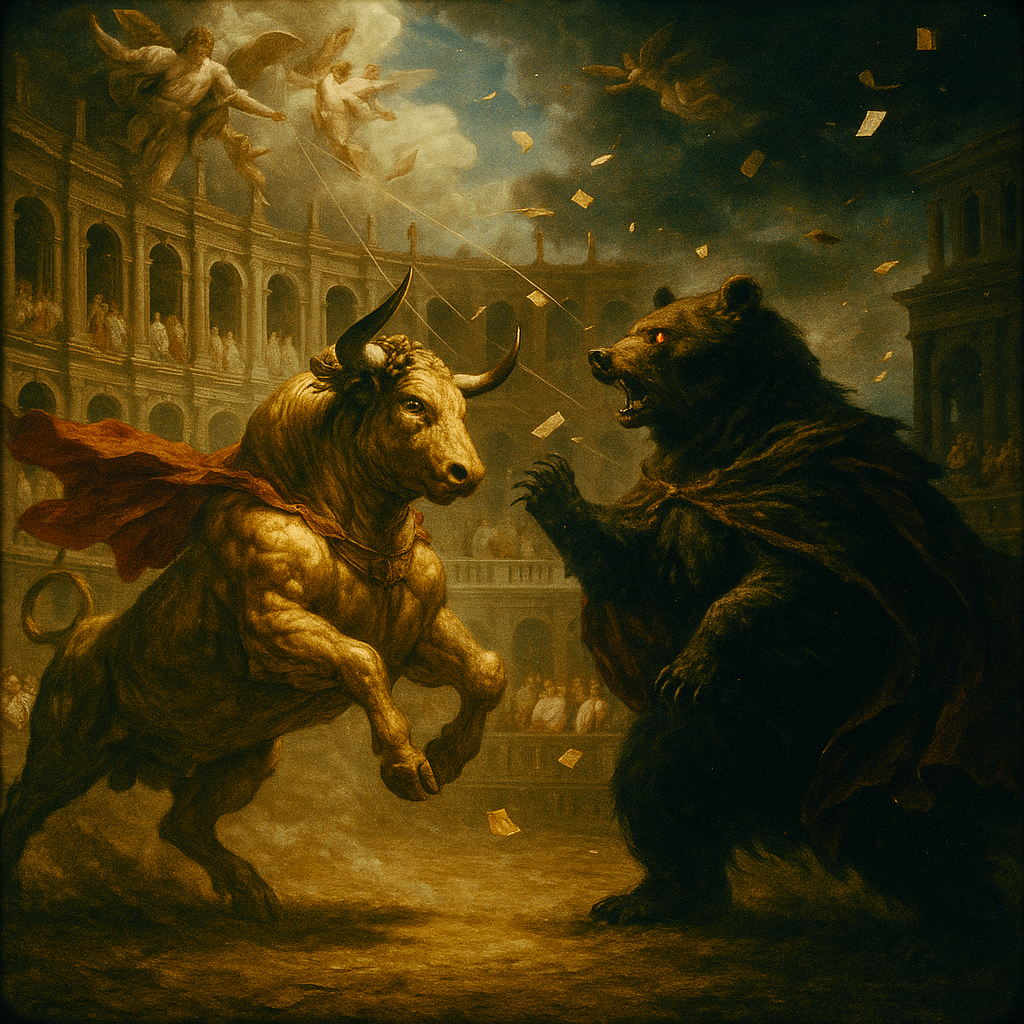Bulls & Bears: Decoding Market Momentum
“Markets can remain irrational longer than you can remain solvent.”
— John Maynard Keynes
The archetypal symbols of financial markets—the charging bull and the swiping bear—aren’t just colorful metaphors. They embody centuries of economic evolution, human psychology, and statistical regularities that define market cycles. From 16th-century commodity trading in London to India’s modern exchanges, understanding bulls and bears is essential for investors aiming to navigate volatility and capture long-term gains.
I. From Bearskin Jobbers to Bear Markets
The term “bear” traces back to 16th-century English traders known as bearskin jobbers. Lacking the bearskins they sold on futures contracts, these middlemen gambled that skin prices would fall before delivery—an early form of short selling1. When prices rose instead, jobbers suffered losses, giving birth to a cautionary proverb:
“Don’t sell the bear’s skin before one has caught the bear.”2
By the 18th century, “bear” had evolved into shorthand for any trader betting on falling markets, laying the foundation for modern bearish sentiment.
II. Bullfighting as Financial Allegory
In contrast, “bull” emerged from the brutal spectacles of 18th- and 19th-century England, where crowds watched chained bears battle free-roaming bulls. Observers noted each animal’s fighting style:
- Bulls thrust horns upward, symbolizing rising prices.
- Bears swipe paws downward, symbolizing falling prices.
This visceral imagery resonated, and by the early 1800s, newspapers used “bull” to describe rising markets and “bear” for declining ones31.
III. Statistical Realities of Bull and Bear Markets
While metaphors capture imagination, data guides strategy. Analysis of U.S. equity markets from 1926 to 2019 shows4:
- Bull markets average 51 months (4.2 years) in duration with 175% cumulative gains.
- Bear markets average 15 months (1.3 years) with 31% cumulative declines.
- Markets spend 78% of the time in bull phases, offering a 3.4:1 time advantage to optimism.
Globally, similar patterns hold, underscoring the value of staying invested through short-lived downturns.
IV. India’s Bull and Bear Chronicles
Since the BSE Sensex launched at 100 in 1979, India has witnessed dramatic cycles:
- 1990–1992 Bull Run: Sensex leaped from 1,001 to 4,500 (350% in 14 months) after economic liberalization under Dr. Manmohan Singh5.
- 1998–2000 Tech Boom: Fueled by Y2K demand, Sensex rose from 2,740 to 6,006 (118% in 16 months)5.
- 2004–2008 Infrastructure Surge: Robust GDP growth propelled a 236% gain over four years, turning ₹1 lakh into ₹3.36 lakh5.
- 2014–2017 Modi Optimism: Political stability and reforms drove the Sensex past 30,000 for the first time.
Bears struck with equal force:
- 1992 Harshad Mehta Scam: A 2,000-point decline ushered a two-year bear market.
- 2008 Financial Crisis: Over 50% peak-to-trough decline, including a 1,408-point drop on January 216.
- 2020 COVID Crash: Sensex lost 3,934 points (13.15%) in one session on March 23, then staged a sharp V-shaped recovery6.
V. Psychology Behind the Charge and Retreat
Bulls ignite euphoria. In 2017, India’s small-cap index soared 59.6%, and select stocks spiked over 1,000% on narrative alone. Bears drive capitulation, where fear overwhelms logic: March 2020’s panic sell-off exemplified this, as investors fled amid unprecedented uncertainty.
Behavioral finance shows that herd mentality and emotional extremes amplify cycles—turning minor corrections into bear markets or fueling unsustainable rallies.
VI. Modern Dynamics and Safeguards
Digital platforms and algorithmic trading compress reactions from days to milliseconds. Retail investors, empowered by zero-commission apps, now amplify both rallies and sell-offs. Social media can spark frenzies overnight, making cycles sharper and shorter.
To temper volatility, exchanges deploy circuit breakers, margin requirements, and real-time risk monitoring. These mechanisms—absent in early market incarnations—help prevent systemic breakdowns during extreme moves.
VII. Strategic Takeaways for Investors
- Time in Market vs. Timing: Given bulls dominate 78% of market time, staying invested through downturns generally yields better outcomes than attempting to time peaks and troughs.
- Diversification is Crucial: A mix of equities, bonds, and alternative assets can cushion bear-market declines while participating in bull-market gains.
- Mind the Metrics: Use valuation indicators (P/E ratios, yield spreads) and macro signals (credit growth, policy shifts) to gauge cycle maturity.
- Embrace Volatility: Bear phases offer opportunities to buy quality assets at discounts. Maintaining liquidity and predefined buy levels can enhance long-term returns.
As India strides toward becoming the world’s third-largest economy by 2027, understanding the bull-bear dialectic—rooted in centuries-old metaphors and validated by robust statistics—remains indispensable. In the grand arena of markets, bulls and bears continue their eternal dance. Recognize their rhythms, and you’ll be poised to ride the waves of prosperity rather than be trampled by them.
References
- https://www.investopedia.com/ask/answers/bull-bear-market-names/
- https://www.vocabulary.com/articles/blogexcerpts/how-did-markets-get-bearish-and-bullish/
- https://www.cnn.com/2022/06/14/business/bear-bull-meaning-wall-street-stocks
- https://russellinvestments.com/us/blog/bulls-vs-bears
- https://insider.finology.in/stock-market/indian-stock-market-biggest-bull-runs
- https://www.goodreturns.in/news/bulls-bleeding-1865-to-2025-which-is-the-biggest-crash-in-sensex-and-nifty-history-of-bears-1417203.html


Leave a Reply